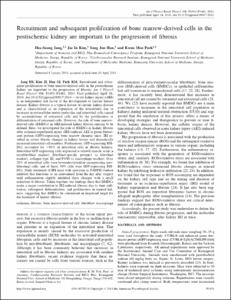KUMEL Repository
1. Journal Papers (연구논문)
1. School of Medicine (의과대학)
Dept. of Molecular Medicine (분자의학)
Recruitment and subsequent proliferation of bone marrow-derived cells in the postischemic kidney are important to the progression of fibrosis
- Keimyung Author(s)
- Kim, Jee In
- Department
- Dept. of Molecular Medicine (분자의학)
- Journal Title
- American Journal of Physiology-Renal Physiology
- Issued Date
- 2014
- Volume
- 306
- Issue
- 12
- Abstract
- Acute kidney injury (AKI) is an independent risk factor of the development of chronic kidney disease. Kidney fibrosis is a typical feature of chronic kidney disease and is characterized as an expansion of the interstitium due to increases in extracellular matrix molecules and interstitial cells caused by accumulations of extrarenal cells and by the proliferation or differentiation of intrarenal cells. However, the role of bone marrow-derived cells (BMDCs) in AKI-induced kidney fibrosis remains to be defined. Here, we investigated the role of BMDCs in kidney fibrosis after ischemia-reperfusion injury (IRI)-induced AKI in green fluorescent protein (GFP)-expressing bone marrow chimeric mice. IRI resulted in severe fibrotic changes in kidney tissues and dramatically increased interstitial cell numbers. Furthermore, GFP-expressing BMDCs accounted for >80% of interstitial cells in fibrotic kidneys. Interstitial GFP-expressing cells expressed α-smooth muscle actin (a myofibroblast marker), fibroblast-specific protein-1 (a fibroblast marker), collagen type III, and F4/80 (a macrophage marker). Over 20% of interstitial cells were bromodeoxyuridine-incorporating (proliferating) cells, and of these, 80% cells were GFP-expressing BMDCs. Daily treatment of IRI mice with apocynin (a NADPH oxidase inhibitor that functions as an antioxidant) from the day after surgery until euthanization slightly inhibited these changes with a small reduction of fibrosis. Taken together, our findings show that BMDCs make a major contribution to IRI-induced fibrosis due to their infiltration, subsequent differentiation, and proliferation in injured kidneys, suggesting that BMDCs be considered an important target for the treatment of kidney fibrosis.
- Keimyung Author(s)(Kor)
- 김지인
- Publisher
- School of Medicine
- Citation
- Hee-Seong Jang et al. (2014). Recruitment and subsequent proliferation of bone marrow-derived cells in the postischemic kidney are important to the progression of fibrosis. American Journal of Physiology-Renal Physiology, 306(12), F1451–F146. doi: 10.1152/ajprenal.00017.2014
- Type
- Article
- ISSN
- 1931-857X
- Appears in Collections:
- 1. School of Medicine (의과대학) > Dept. of Molecular Medicine (분자의학)
- 파일 목록
-
-
Download
 oak-aaa-00195.pdf
기타 데이터 / 2.85 MB / Adobe PDF
oak-aaa-00195.pdf
기타 데이터 / 2.85 MB / Adobe PDF
-
Items in Repository are protected by copyright, with all rights reserved, unless otherwise indicated.